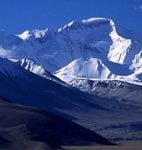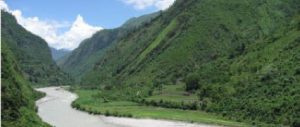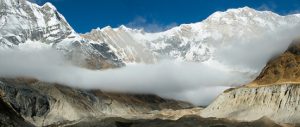Everest Base Camp is undergoing dramatic changes. “Usually in April the springs around the camp are frozen. Last year, we reached the camp in late April and found them gushing,” said Shailee Basnet, a young journalist from Nepal who climbed Everest in 2008.
I met her at a regional climate change conference held in Kathmandu at the beginning of this month. Further up the mountain, Shailee told me that the signs of climate change were even more evident — the Khumbu ice wall was moving, with ice towers falling and cracking. “The ice wall is supposed to be stable at this time of the year — it has become very difficult for climbers now”.
Basnet’s anecdotal evidence is echoed by other climbers who visit these high mountains regularly. Some of them were at the conference hosted by the government of Nepal with funding from international organisations. Held at a local hotel, the conference brought together scientists, policymakers, donor agencies, journalists and various NGOs working in the Himalayan region.
The NGOs reported on the villagers’ observations of receding glaciers, apricots blooming much earlier and mosquitoes infesting higher altitudes. Clearly something is happening in the mountains of the Himalayas, the Karakorams and the Hindu Kush, although scientific data to explain these changes is patchy and there are many blank spots.
According to a statement released by the World Bank, “Where detailed studies have been carried out, the range of glacier dynamics are so complex that it’s virtually impossible to generalise and dangerous to fix on one figure or another”. What is needed is science-based research involving the local people who have considerable local knowledge.
This mountainous area, given the general title of the “Hindu Kush-Himalayan region” (HKH) by the International Centre for Integrated Mountain Development (ICIMOD) includes the Tibetan plateau, where melting permafrost is causing houses to collapse. According to some scientists, “The rates of warming in the HKH region are significantly higher than the global average.” They say that “all aspects of human and natural life will be affected”.
Villagers in this mountain region also rely heavily on the monsoon systems and these may be altered by climate change. Already, the monsoons have arrived late in Nepal, India and Pakistan this year, causing crops to fail. In this context, the idea behind the climate-change conference in Kathmandu was to bring together all the countries in the HKH region to come up with “a vision for addressing climate change risks and vulnerabilities in the Himalayas”.
Unfortunately, the conference was far from successful in coming up with a shared vision. Ministers from the regional countries were expected to come, but that did not happen.
Countries with no direct links with the Himalayas, but who will suffer from sea-level rise caused by glacial melt like the Maldives, Sri Lanka and Bangladesh (which will also suffer from flooding rivers) showed up in full force. However, China declined to participate, Bhutan did not even bother showing up and Pakistan sent a low-level delegation, including a section officer from the ministry of environment.
The Indian team, which at least included high-level secretaries, apparently dissented on announcing a “Kathmandu Declaration” at the end of the conference. A seasoned Nepali journalist attending the conference asked the Nepali minister reading the statement in Nepalese why there was no declaration. The journalist told me later, “He really had no answer to give aside from the fact that it was an ‘agreed statement’. It was not even a signed statement so I asked him could you at least sign it so I can quote you in my report.”
The rather general statement highlighted the fact that “South Asia including the HKH region is a climate-change hotspot that influences the lives of half of the world’s population”. The statement also called for the generation and sharing of data on the region and adaptation at all levels through collaborative efforts. Since water resources are particularly impacted, the statement called for basin-wide approaches at appropriate levels. It asked the industrialised countries to pay for adaptation and clean technologies.
The statement skirted around the issue of local pollution and regional carbon emissions — which is disturbing because scientists are pointing out that an “atmospheric brown cloud” is depositing black carbon and aerosols from industries onto the high mountains, adding to temperature rise.
Black carbon is produced by diesel engines, coal-powered power plants, forest fires and wood- and dung-burning stoves. According to the director-general of ICIMOD, “We know that black carbon and aerosols are having a dramatic impact but again there is no research as yet.”
With settlements increasing in the mountains themselves, not to mention the rapidly sprawling cities of Asia, this is a growing problem. Although it is short-lived, black carbon is extremely polluting and regional countries need to address this kind of emission. However, with China opening up one new coal plant every week and India opening up a number of thermal power plants, I guess this is not something that the two regional leaders want to address at the moment given their high economic growth rates.
Those from international organisations tried to put a positive spin on the conference by announcing increased funding and more programmes on climate resilience. According to Claudia Sadoff of the World Bank, “We know that there are scientific data gaps and that we need to tailor interventions to micro-climates … but let’s try for the 10% solutions”. Some solutions are certainly better than no solutions — but I wish the participating countries had realised that if they can’t get together and build a regional consensus on climate change, they can’t expect to come up with a global consensus in Copenhagen.
Rina Saeed Khan is a Lahore-based freelance journalist, with an MSc in Environment and Development from the London School of Oriental and African Studies.
This article first appeared in DAWN. It is translated and reproduced here with permission.
Homepage image of Everest Base Camp in Nepal by Mahatma4711


